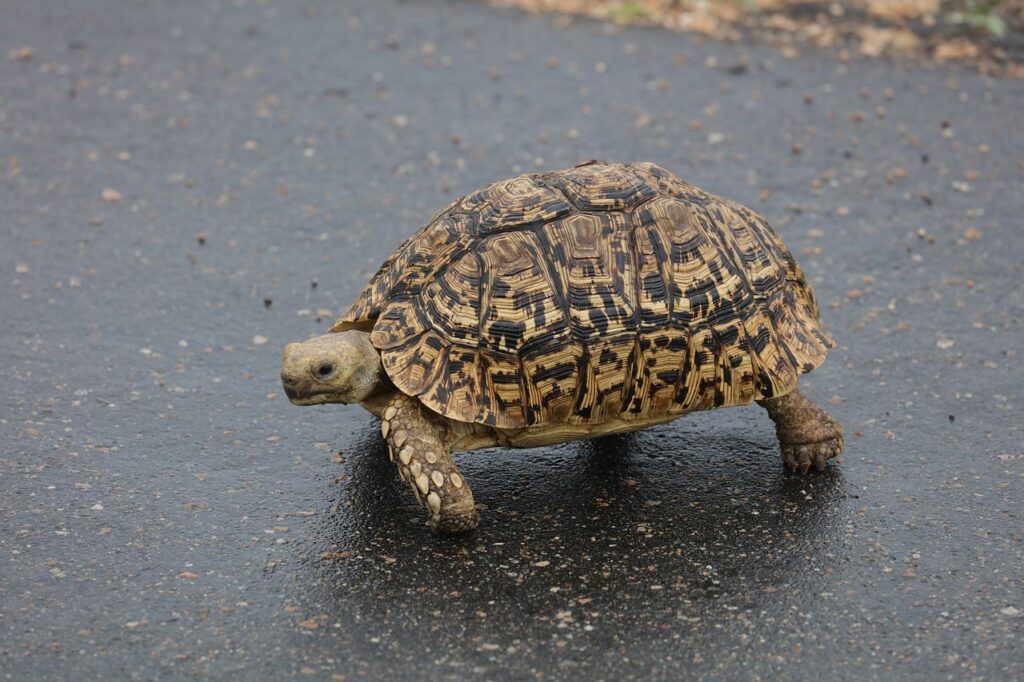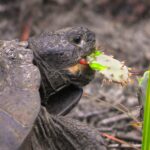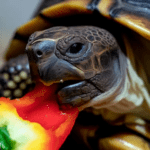Leopard tortoises are fascinating creatures, with unique dietary needs. It is essential to understand what they eat for their health and wellbeing.
They are herbivores, and their diet consists of grasses, leaves, flowers, and cacti. These resilient animals have adapted to thrive in dry environments, eating food with high levels of moisture.
For optimal vitality, it is important to provide a range of vegetation. Dark leafy greens like kale and collard greens offer essential vitamins and minerals, while edible flowers like hibiscus and dandelion can increase their nutritional intake. To support shell development and bone health, calcium-rich food like cuttlebone or supplements should be added to their meals, especially for young tortoises who are still growing.
It is important to avoid feeding them certain foods that may be toxic or unhealthy. High sugar fruits and vegetables like spinach can inhibit calcium absorption, so these should be avoided. Additionally, it is wise to wash all foliage before offering it to your tortoise to remove any pesticides or chemicals.
Leopard tortoises take their time when deciding what to eat – fascinating creatures!
Key Takeaways
- Leopard tortoises are herbivores and primarily eat a diet of grasses and plants.
- They have a high fiber requirement and need a variety of vegetation to maintain a healthy digestive system.
- In captivity, their diet should consist of a mix of grasses, leafy greens, and vegetables.
- It is important to avoid feeding them foods that are high in protein or fat, as this can lead to health issues.
- Providing a calcium supplement is crucial for their shell and bone health.
- Leopard tortoises should have access to fresh water at all times, although they do not drink much water and get most of their hydration from their food.
- It is important to research and understand the specific dietary needs of leopard tortoises to ensure they are getting the proper nutrition.
General Information about Leopard Tortoises

Leopard tortoises are from South Africa’s grasslands. They have a cool patterned shell and are gentle. People like them, so they’re kept as pets. They live a long time and don’t need much care.
These tortoises can grow to 18″ and weigh 40 pounds. They’re fast and agile too, thanks to their strong legs. They eat grasses, weeds, shrubs, flowers, and succulent plants. Their jaws chew tough plants easily. High fiber food helps them stay healthy.
To keep them nourished, offer a variety of leafy greens, like kale, collard greens, dandelion greens, and turnip greens. For veggies, try carrots, bell peppers, squash, and sweet potatoes. Fruits like strawberries and melons make good treats.
During mating season, male tortoises battle each other with head-butts! It may go on for hours or days, until one becomes the winner. Do Leopard Tortoises have a taste for adventure in their diet or are they just leafy greens enthusiasts?
Diet and Nutrition of Leopard Tortoises
Leopard tortoises have dietary needs to stay healthy. It’s important to know what to feed them and how to do it. Here’s a table on their diet and nutrition:
| Food | Quantity | Frequency |
|---|---|---|
| Leafy greens | A handful | Daily |
| Hay | A bundle | Daily |
| Moistened pellets | 2-3 pieces | Weekly |
| Variety of vegetables | Small portions | Every other day |
| Calcium supplements | As directed by vet |
Leopard tortoises mainly eat leafy greens, like dandelion, collard, and mustard. Hay gives them fiber. Moistened pellets contain necessary nutrients, but should be given in moderation. Veggies, like bell peppers, carrots, and squash, add variety. Calcium supplements help with bone growth and shell development.
Fun fact: Leopard tortoises store water in their bladder lining, so they can go long periods without fresh water.
For leopard tortoises to be healthy, they need the right diet. Feed them a balanced and varied diet, and they’ll be happy and thriving. Avoid forbidden foods, or they may try to escape!
Foods to Avoid for Leopard Tortoises

Leopard tortoises have dietary needs that must be met to stay healthy. Many foods are OK to feed them, but some should be avoided. High protein foods like meat and insects are harmful, as are dairy products, high-fat foods, and toxic plants. Fruits should be limited due to the high sugar content.
Tessa is a leopard tortoise who was raised with perfect nutrition. Her family researched her diet, but a friend gave her cooked chicken which made her sick. This shows how important it is to stick to the right diet for leopard tortoises.
Feeding a leopard tortoise the right food is vital for their well-being. So, buckle up and get ready to learn about their ‘shell’ of a diet!
Feeding Schedule for Leopard Tortoises

Leopard tortoises have dietary needs which must be looked after to keep them healthy. Here are three key points when creating a feeding plan:
- Fresh veggies: Give them a variety of fresh vegetables like kale, collard greens, and dandelion greens. Plus, vegetables like peppers and squash supply needed vitamins and minerals.
- Hay and grasses: Provide hay or dried grasses for your tortoise all the time. It helps digestion, and gives them fiber.
- Calcium: Leopard tortoises need calcium for their shells. Dust their food with a calcium supplement – ask a vet for advice.
Monitor your tortoise’s weight and adjust the feeding schedule accordingly. Avoid overfeeding, and don’t underfeed either.
Pro Tip: Always give them clean, fresh water daily.
And one more tip: Don’t feed them carrot cake no matter how much they plead!
Tips for Ensuring a Healthy Diet for Leopard Tortoises
A nutritious diet is essential for leopard tortoises’ health. Here are some tips to make sure your pet stays happy:
- Offer leafy greens such as collard greens, dandelion greens, and kale.
- Include vegetables like carrots, squash, and bell peppers.
- Treat them with fruits like strawberries or melons.
- Sprinkle calcium powder on their food for proper shell growth.
- Avoid high-protein foods like meats or dairy.
- Don’t forget to provide freshwater.
Bear in mind that each tortoise may have different dietary needs. Watch your pet closely to customize their diet.
Did you know that leopard tortoises are named for the pattern on their shells resembling a leopard’s coat? Fascinating!
In conclusion, leafy greens, vegetables, and treats are essential for your leopard tortoise’s well-being. Keep them hydrated and pay attention to their preferences for a healthy and happy pet. Wrap it up like a tortoise’s favorite meal – because now you know what leopard tortoises eat – and it’s not fast food!
Frequently Asked Questions
Q: What do leopard tortoises eat?
A: Leopard tortoises primarily eat grasses, weeds, and succulent plants.
Q: Can leopard tortoises eat fruits and vegetables?
A: Yes, they can eat small amounts of fruits and vegetables as occasional treats, but these should not be a significant part of their diet.
Q: What types of grasses are suitable for leopard tortoises?
A: Leopard tortoises can eat a variety of grasses such as Bermuda grass, Timothy grass, and Kentucky bluegrass.
Q: Do leopard tortoises need any supplements?
A: It is recommended to provide leopard tortoises with calcium supplements, such as calcium powder or cuttlebone, to ensure proper shell development.
Q: Can leopard tortoises eat commercial tortoise pellets?
A: Commercial tortoise pellets can be given occasionally as a supplement, but they should not be the main source of nutrition for leopard tortoises.
Q: Are leopard tortoises sensitive to certain foods?
A: Yes, leopard tortoises are sensitive to foods high in oxalates, such as spinach and rhubarb, which can inhibit calcium absorption and lead to health issues.
Conclusion
Leopard Tortoises munch on grass and fruits! Yum! They also love leafy greens and succulent flowers. Mushrooms are a special treat too. To keep their shells strong, calcium-rich supplements should be added to their diet. A balanced diet is essential. Check out different options to keep your Leopard Tortoise happy!
References




